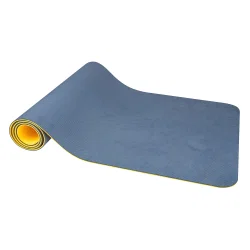Here’s a detailed overview of what to look for in a yoga folding mat
2024-06-15
A yoga folding mat is a convenient and portable alternative to traditional yoga mats, ideal for those who travel frequently or have limited storage space. Here’s a detailed overview of what to look for in a yoga folding mat, including some top recommendations:
Key Features to Consider
1. Material
- PVC: Durable and offers good grip, but not environmentally friendly.
- TPE (Thermoplastic Elastomer): Eco-friendlier, lightweight, and offers a good balance of grip and cushioning.
- Natural Rubber: Offers excellent grip and cushioning, eco-friendly but heavier.
- Microfiber: Often used in combination with natural rubber, provides a soft, absorbent surface.
2. Thickness
- 1-2mm: Ultra-thin and lightweight, easy to fold but offers less cushioning.
- 3-4mm: Standard thickness for most yoga mats, balances portability with comfort.
- 5mm+: Provides more cushioning, suitable for those needing extra joint support, but may be bulkier when folded.
3. Portability
- Look for mats designed to fold into a compact size, often into squares or rectangles.
- Some mats come with carrying cases or straps for added convenience.
4. Grip and Texture
- Ensure the mat has a non-slip surface to prevent slipping during poses.
- Textured surfaces provide better grip, especially when wet.
5. Durability
- Check for reviews on wear and tear, especially if you plan to use the mat frequently.
Top Yoga Folding Mat Recommendations
1. Manduka eKO Superlite Travel Yoga Mat
- Material: Natural rubber.
- Thickness: 1.5mm.
- Features: Lightweight, foldable, excellent grip.
- Pros: Eco-friendly, very portable.
- Cons: Less cushioning due to thinness.
- Price: ~$45.
2. Jade Yoga Voyager Mat
- Material: Natural rubber.
- Thickness: 1.6mm.
- Features: Foldable, non-slip surface, eco-friendly.
- Pros: Lightweight, great grip, sustainable.
- Cons: Limited cushioning.
- Price: ~$40.
3. Liforme Travel Yoga Mat
- Material: Eco-polyurethane and natural rubber.
- Thickness: 2mm.
- Features: Foldable, alignment guides, excellent grip.
- Pros: Great for alignment, good grip.
- Cons: Expensive.
- Price: ~$120.
4. YOGO Ultralight Folding Yoga Mat
- Material: Natural rubber.
- Thickness: 1.5mm.
- Features: Foldable into a small rectangle, comes with attached straps.
- Pros: Very portable, eco-friendly.
- Cons: Thin, less cushioning.
- Price: ~$68.
5. Gaiam Foldable Yoga Mat
- Material: PVC.
- Thickness: 2mm.
- Features: Folds into a compact square, sticky texture for grip.
- Pros: Affordable, portable.
- Cons: Made from PVC, less durable.
- Price: ~$24.
Conclusion
When choosing a yoga folding mat, consider your specific needs, such as the frequency of travel, storage space, and the type of yoga you practice. The mats listed above are some of the best options available, offering a balance of portability, grip, and durability. Always read customer reviews and product specifications to ensure the mat meets your requirements.



